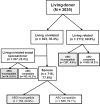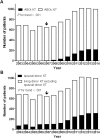Impact of ABO incompatible kidney transplantation on living donor transplantation
- PMID: 28323892
- PMCID: PMC5360260
- DOI: 10.1371/journal.pone.0173878
Impact of ABO incompatible kidney transplantation on living donor transplantation
Abstract
Background: ABO incompatible kidney transplantation (ABOi-KT) is an important approach for overcoming donor shortages. We evaluated the effect of ABOi-KT on living donor KT.
Methods: Two nationwide transplantation databases were used. We evaluated the impact of ABOi-KT on overall living donor transplant activity and spousal donation as subgroup analysis. In addition, we compared the clinical outcome between ABOi-KT and ABO compatible KT (ABOc-KT) from spousal donor, and performed a Cox proportional hazards regression analysis to define the risk factors affecting the allograft outcomes.
Result: The introduction of ABOi-KT increased overall living donor KT by 12.2% and its portion was increased from 0.3% to 21.7% during study period. The ABOi-KT in living unrelated KT was two times higher than that of living related donor KT (17.8 vs.9.8%). Spousal donor was a major portion of living unrelated KT (77.6%) and ABOi-KT increased spousal donation from 10% to 31.5% in living donor KT. In addition, increasing rate ABOi-KT from spousal donor was 10 times higher than that of living related donor. The clinical outcome (incidence of acute rejection, allograft function, and allograft and patient survival rates) of ABOi-KT from spousal donor was comparable to that of ABOc-KT. Neither ABO incompatibility nor spousal donor was associated with acute rejection or allograft failure on multivariate analysis.
Conclusions: ABOi-KT increased overall living donor KT, and ABOi-KT from spousal donor is rapidly increasing with favorable clinical outcomes.
Conflict of interest statement
Figures






References
-
- Korean Statistical Information Service. Available at http://kosis.kr/statisticsList/statisticsList_01List.jsp?vwcd=MT_ZTITLE&.... Accessed 10th, September, 2015.
-
- Yoon HE, Song JC, Hyoung BJ, et al. Comparison of long-term outcomes between spousal transplants and other living unrelated donor transplants: single-center experience. Nephron. Clin Prac. 2009;113(4):c241–249. - PubMed
-
- Korean Network for Organ Sharing. KONOS Annual Report. Available at http://www.konos.go.kr/konosis/common/bizlogic.jsp. Accessed 10th, September, 2015.
MeSH terms
Substances
LinkOut - more resources
Full Text Sources
Other Literature Sources
Medical

